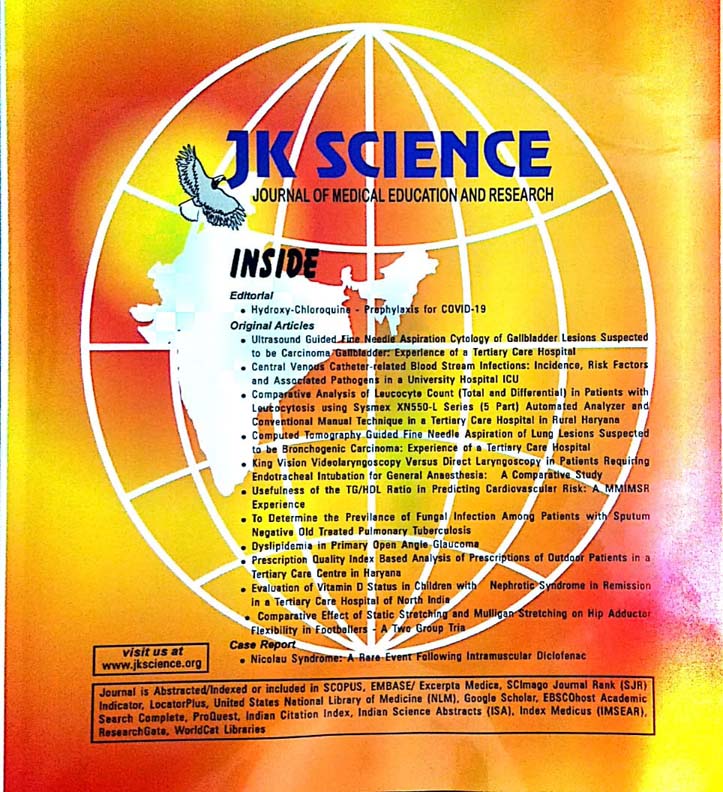
pISSN: 0972-1177

Dr. Annil Mahajan
Editor-in-General

Dr. Sudhaa Sharma
Editor-in-General
Scope of Journal
JK Science is a Multi-disciplinary Medical Journal. It welcomes articles from all medical specialities. It accepts Editorial (Invited only), Review Articles, Original Articles, Case Reports, Research letters, Drug Reviews & Images.
Preparation of Manuscripts
| Article Type | Abstract: No. of Words | Key Words: No. of Words | Text: No. of Words | Sub-Headings | Tables: Max. No. | Figures: Max. No. | No. of References |
|---|---|---|---|---|---|---|---|
Authorship Criteria
Submission of Manuscripts
1) Title Page/Covering Letter
2) Article File
3) Images
The Contributors'/Copyright Transfer Form has to be submitted with the signatures of all the contributors via email as a scanned image.
It is mandatory to send the conflict of interest form for each author separately along with the main manuscript submission. Please note that the conflict of interest form is separate from the copyright transfer form.
| Manuscript Submission: Check List For Contributors |
|---|
| 01. Letter of Submission. |
| 02. Copyright Statement signed by all the Authors. |
| 03. Title Page: Title of Manuscript, Full Name(s) and Affiliations of Author(s), Institution(s) and City(ies) from which work originated; Name, Address, Telephone & E-mail address of Corresponding Author |
| 04. Structured Abstract and 3-5 Key Words for Original Articles & Unstructured Abstract for Case Reports. |
| 05. Article Proper (Double spaced with liberal margins). |
| 06. Acknowledgements. |
| 07. CONSORT Statement in case of reporting RCT. |
| 08. Latest References (Vancouver style). |
| 09. No repetition of Data in Tables/Graphs and in Text |
| 10. Figures / Diagrams of good quality (colour). |
| 11. Photographs appropriately Marked and with Legends |
| 12. Submission on-line through the website (https://journal.jkscience.org) or through e-mail at [email protected] |
Sending a Revised Manuscript
The revised version of the manuscript should be submitted online in a manner similar to that used for submission of the manuscript for the first time. However, there is no need to submit the “Title Page” or “Covering Letter” file while submitting a revised version. When submitting a revised manuscript, contributors are requested to include, the ‘referees’ remarks along with point to point clarification at the beginning in the revised file itself. In addition, they are expected to mark the changes as underlined or colored text in the article.
| Some Tips To Revise The Manuscript |
|---|
| 01. Submit revised version through website or through e-mail. |
| 02. Go through the comments of referees carefully |
| 03. Carry out all corrections |
| 04. Highlight the changes with some different colour in revised manuscript. |
| 05. If your data need to be re-analysed, consult biostatistician. |
| 06. Do not ignore any comment / remark / query of the referees |
| 07. If you feel a comment / suggestion by the referee is incorrect / unacceptable, reply by explaining the reasons. |
| 08. Point-by-point explanation is must. |
Proof Correction
The corresponding author will receive the designed article through email. Hence a working email address must therefore be provided for the corresponding author. Its purpose is for the essential correction of errors, to check the accuracy and positioning of tables and figures and/or approval that no further corrections are required. The proof will be in PDF (portable document format). Instructions will be sent with the proof. Corrected Proofs must be returned within three days of receipt. It may not be possible to incorporate corrections received after that period.
Manuscript Withdrawl
Some authors request withdrawal of manuscript after submission. If the withdrawal is done within the time span when the article is with Editor, and for a genuine reason, author is allowed to withdraw the manuscript without any penalty. If the author withdraws manuscript any time after the manuscript has been sent to peer review till the final decision, then unless there are compelling reasons, the request is not entertained without a penalty. This penalty may be in the form of payment to journal for its time and resources spent.
Publication Schedule
The journal is published quarterly - 04 issues per year. Both print and online versions.
Guidelines to Contributors
Template for Covering Letter/ Title Page
Contributors' Form
ICMJE - Conflict of Interest Form

pISSN: 0972-1177

Dr. Annil Mahajan
Editor-in-General

Dr. Sudhaa Sharma
Editor-in-General
|
Editors-in-General |
Editors-in-Chief |
Managing Editor |
Statistical Editor |
Editorial Secretaries |
© 1999 to Present, JK Science: Journal of Medical Education & Research
pISSN: 0972-1177
Published by Dr. Annil Mahajan from Jammu (J&K), India

This work is licensed under a Creative Commons International License
CC BY-NC-SA 4.0
